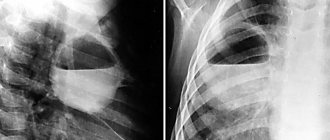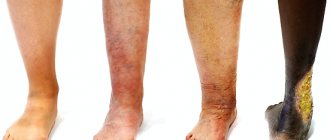Endometrial cancer develops on the inner lining of the uterus. Among all cancers of the female genital organs in the United States, this type of cancer is the most common; in the Russian Federation, its frequency is second only to breast cancer. But despite this, it is less likely than other forms to cause death, since in 7 out of 10 women it is detected at the initial stage of development. And in this case, it is treatable.
In recent years, endometrial carcinoma has begun to “get younger.” If previously it affected mainly postmenopausal women, today it is quite common in 40-50 years. The incidence is also increasing at a young age. The average age of the patient today is 63 years.
Symptoms
Endometrial cancer can cause symptoms such as unexplained pain, fatigue, and heaviness in the pelvic area. Photo: Vk.
Early signs and symptoms include unusual bleeding, such as after menopause or between periods.
Pain may occur in the pelvic area or during sexual intercourse. Some women also experience pain when urinating or have difficulty emptying their bladder.
As the disease progresses there may be:
- feeling of excess weight or heaviness in the pelvic area;
- unintentional weight loss;
- fatigue;
- nausea;
- pain in several parts of the body, including the legs, back and pelvic area.
Other noncancerous health problems have similar symptoms, such as fibroids, endometriosis, endometrial hyperplasia, or polyps in the lining of the uterus.
difference between normal endometrium and hyperplasia. Photo: Pinterest.
polyps in the uterine cavity. Photo: Pinterest.
It is important to rule out endometrial cancer if other conditions cause similar symptoms.
Stages
If cancer is found, you need to understand what stage the patient has to see how quickly the cells are dividing and how quickly the cancer can grow.
A higher stage tumor will grow quickly and spread to other parts of the body.
Treatment will depend on the stage, or how far the cancer has spread.
The following stages exist:
- Stage 0 : Cancer cells remain on the surface of the lining of the uterus.
- Stage 1 : The cancer has spread through the lining of the uterus to the endometrium and possibly the myometrium.
- Stage 2 : The tumor has spread to the cervix.
- Stage 3 : The tumor has spread through the uterus to nearby tissues, including the vagina or lymph node.
- Stage 4 : The cancer has spread to the bladder or bowel and possibly to other areas such as the bones, liver or lungs.
When endometrial cancer spreads from the endometrium to other parts of the body and when, for example, a new tumor forms in the lungs, that new tumor is not lung cancer. This type of tumor is known as metastatic endometrial cancer.
Varieties
Based on localization and spread to neighboring organs, endometrial cancer or uterine precancer is divided into the following degrees:
- damage only to the mucous layer of the uterus;
- with distribution to all layers of the organ;
- precancerous lesions of the cervix;
- oncology moves beyond the uterus;
- damage to nearby internal organs by this disorder;
- spread of cancer metastases to distant organs and lymph nodes.
Absolutely all stages of the disease can be diagnosed using ultrasound.
Treatment
Treatment depends on the age and general health of the woman with endometrial cancer, as well as the stage of the tumor.
Treatment options: surgery, radiation therapy, chemotherapy and hormone therapy.
Surgery
Surgical treatment for endometrial cancer usually takes the form of a hysterectomy, or removal of the uterus along with the fallopian tubes and ovaries. This usually involves a hospital stay and resuming normal activities may take 4 to 8 weeks.
A woman who has not yet gone through menopause will no longer have periods after surgery and will not be able to become pregnant. She may experience menopausal symptoms such as hot flashes, night sweats, and vaginal dryness.
Radiation therapy
Radiation therapy uses powerful rays to kill cancer cells. This damages their DNA so that they can no longer reproduce.
With external beam radiation, the beam is directed to the pelvis and other areas with cancer. Up to five sessions can be performed each week over several weeks. The session lasts about 15 minutes.
Brachytherapy, or internal radiation therapy, uses small devices filled with radiation, such as wires, a cylinder or small particles. They are placed in the vagina for a few minutes and then removed. Then the patient returns home. Therapy is repeated two or more times over several weeks. Removing the device removes radiation from the body.
Neo-adjuvant radiation therapy aims to shrink the tumor before surgery, making it easier to remove.
Adjuvant radiation therapy may also be given after surgery to eliminate any remaining cancer cells.
Side effects of radiation therapy include burned skin in the treated area, hair loss, fatigue, nausea and diarrhea. After treatment, side effects usually go away.
Chemotherapy
a woman who has undergone chemotherapy. Photo: Twitter.
Chemotherapy uses drugs to kill cancer cells. Combined with radiation therapy, it can remove any remaining tumor.
For advanced cancer, chemotherapy can slow the progression of the disease and prolong life.
Both radiation and chemotherapy can help relieve symptoms in patients with advanced cancer.
For endometrial cancer, chemotherapy is usually given intravenously. There is a rest period for the body to recover. The cycle is repeated several times, depending on the stage and goals of treatment.
Possible side effects include a decrease in the number of healthy blood cells, leaving the patient with bruising, bleeding, anemia, fatigue and an increased risk of infection. If these symptoms occur, you should consult a doctor.
Chemotherapy can also cause hair loss and gastrointestinal problems, including nausea, vomiting, diarrhea and poor appetite. There may be sores to the lips and mouth.
These problems usually go away after treatment is completed.
Less common effects include swollen legs and feet, joint pain, balance problems, hearing problems, skin rashes, and numbness and tingling in the arms and legs.
Hormone therapy
Hormone therapy may help patients with advanced endometrial cancer. Photo: Pinterest.
Women with very early-stage cancer and low-grade tumors who want to become pregnant may choose hormone therapy rather than surgery.
This is not a standard treatment and requires careful monitoring. If the cancer is in complete remission after 6 months of hormone therapy, the woman will be advised to get pregnant and give birth, and then have a hysterectomy after giving birth to reduce the risk of the cancer returning.
Hormone therapy for endometrial cancer involves taking a progestin, which helps shrink swelling and control symptoms, and also lowers estrogen levels, making it harder for cancer cells to grow.
Side effects include weight gain, mild muscle cramps, and mild nausea.
Main treatment options for endometrial cancer
If the presence of a malignant endometrial tumor is confirmed, complex treatment is prescribed, which includes the following steps:
- operation;
- irradiation;
- chemotherapy;
- treatment with hormonal drugs.
Surgical intervention involves removal of the body and neck of the reproductive organ, as well as appendages. This treatment method is the main and main method of treating endometrial cancer. Depending on the stage of the disease, it may be necessary to remove nearby lymph nodes. After the operation, a course of radiation (radiation therapy) is prescribed. It can be intracavitary or remote. If the malignant process has spread to other organs and tissues, with relapses of the disease and complications, a course of chemotherapy is prescribed.
Treatment with hormone-containing drugs is carried out in a hospital setting. Drugs that contain progestogens are prescribed (for example, Tamoxif, Faslodex).
Risk factors
Although the direct causes of endometrial cancer are unknown, there are several factors that can increase the risk of the disease.
A major factor in endometrial cancer is increased exposure to high levels of estrogen.
They are usually elevated in those who:
- never been pregnant;
- menstruation began before age 12;
- Menopause occurred after age 55.
Estrogen-only contraceptive hormone therapy also contributes to the risk of endometrial cancer.
Polycystic ovary syndrome (PCOS) can increase estrogen levels and is therefore also a risk factor.
Diabetes may increase your risk because estrogen levels tend to rise with insulin levels. Long-term high levels of estrogen increase the likelihood of developing uterine cancer.
Other factors include:
- endometrial hyperplasia, or abnormal growth or thickening of the lining of the uterus;
- obesity;
- hypertension;
- using tamoxifen to prevent or treat breast cancer;
- radiation therapy to the pelvis;
- family history of uterine cancer;
- previous diagnosis of ovarian or breast cancer.
Some reports link acrylamide, a cancer-causing compound found in charred, carbohydrate-rich foods, to endometrial and ovarian cancer in postmenopausal women.
However, other reports disputed this.
Early signs
It is important to recognize the early signs of endometrial cancer so that treatment can begin as quickly as possible!
These early signs include:
- vaginal bleeding between periods;
- periods that are heavier than usual;
- vaginal bleeding in postmenopausal women;
- abnormal vaginal discharge that is watery or tinged with blood.
If you notice any abnormal vaginal discharge or unusual periods, consult your doctor immediately!
Causes of the disease
The main causes of uterine precancer include:
- female gynecological diseases;
- disorder or complete cessation of menstruation;
- taking large amounts of medications that contain too much estrogen;
- genetic predisposition. If one of your close relatives suffered from such an illness, then there is a high probability of recurrence of endometrial cancer in other relatives;
- prolonged abstinence from sexual intercourse;
- frequent change of sexual partners;
- absence of children, and, accordingly, pregnancy and childbirth in a woman, as well as in the case of bearing her first baby at the age of more than thirty years;
- artificial termination of pregnancy, more than once;
- the appearance of the first menstruation in a girl under the age of twelve;
- critical increase in body weight;
- a history of diabetes mellitus;
- mental disorders;
- unhealthy lifestyle, abuse of alcoholic beverages and smoking;
- prolonged exposure to stressful situations;
- a sharp decrease in immunity;
- untimely ultrasound examination of the genital organs;
- the onset of menopause over the age of fifty-five.
Diagnostics
To diagnose this type of cancer, your doctor will look at your symptoms as well as your medical and family history. They will also perform a pelvic examination.
The doctor will examine your cervix, uterus, vagina, and labia to look for lumps or changes in shape or size.
Diagnostic methods:
- A transvaginal ultrasound scan can determine the size and shape of the uterus and the texture and thickness of the endometrium to rule out other conditions. A probe is inserted into the vagina and sound waves create a video image of the uterus on a monitor.
- Blood tests can also detect cancer cells.
- A biopsy involves removing a sample of tissue or cells to be examined under a microscope. This may be a hysteroscopy, in which a thin telescope is inserted into the vagina and uterus, or a suction biopsy, which uses a small flexible tube to take samples of cells.
- Tests to detect the spread of endometrial cancer include a Pap test, a lymph node biopsy, and imaging tests such as X-rays, PET scans, or MRIs.
Pathogenesis
There are two different pathogenetic variants of endometrial cancer. Endometrial cancer is most common in young perimenopausal women with a history of chronic estrogen exposure. This type of cancer is called estrogen-dependent endometrial cancer (the first pathogenetic variant), which occurs through the progression of endometrial hyperplasia. Such tumors are usually highly differentiated and have a favorable prognosis.
The second pathogenetic variant of endometrial cancer belongs to the estrogen-independent type. This type of cancer is not usually associated with endometrial hyperplasia and occurs more often in older, thin, postmenopausal women. This cancer is less differentiated and has a slightly worse prognosis.
The most common type of endometrial cancer is adenocarcinoma (endometrioid adenocarcinoma in 80% of cases). Other types of endometrial cancer include mucinous (5%), clear cell (5%), papillary serous (4%), and squamous cell carcinoma (1%). Invasive adenocarcinoma often arises from the proliferation of endometrial glandular cells rather than from stromal proliferation. The degree of abnormality of these glandular cells forms the basis of the histopathological grading of the tumor. Metastatic damage to the endometrium can occur with tumors of the breast, ovaries, stomach, colon and pancreas. About 3% of cases of uterine body cancer are represented by sarcomas, in particular endometrial stromal sarcomas and malignant mixed Müllerian tumors.
Oncogenesis . About 20% of endometrial cancer cases have an increase in DNA content in tumor cells (aneuploidy). Microsatellite DNA instability occurs in 20% of endometrial cancers, which are usually classified as the first pathogenic variant and have a better prognosis.
Forecast
The average 5-year survival rate for endometrial cancer overall is about 81.3 percent and 95.3 percent for those diagnosed at the earliest stage.
To reduce your risk, the National Cancer Institute recommends avoiding smoking, exercising regularly, and eating a healthy, balanced diet!
Sources:
- www.cancer.gov/…/endometrial-treatment-pdq (English)
- www.cancer.gov/…/endometrial-treatment-pdq (English)
- www.ncbi.nlm.nih.gov/…/25516180 (English)
- www.ncbi.nlm.nih.gov/…/26905095 (English)
- seer.cancer.gov/…corp.html (English)
- www.cancer.org/…/detection-diagnosis-staging/signs-and-symptoms.html (English)
- www.cdc.gov/…/statistics/ (English)
- www.cancerresearchuk.org/…/womb-cancer/stages (English)
Updated: January 2020.
Rating:
[Total votes: 11 Average rating: 5]











